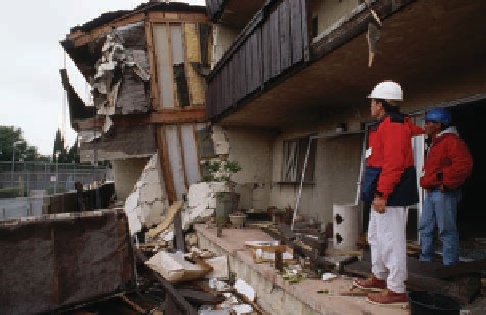Geology Reference
In-Depth Information
◗
Figure 8.6
Earthquake Damage in the Circum-Pacifi c Belt
Damage in Oakland, California, resulting from the October
1989 Loma Prieta earthquake. The columns supporting the
upper deck of Interstate 880 failed, causing the upper deck
to collapse onto the lower one.
b
Some of the damage in Kobe, Japan, caused by the
January 1995 earthquake in which more than 5000 people
died.
a
View of the severe exterior damage to the Northridge
Meadows apartments in which 16 people were killed
as a result of the January 1994 Northridge, California
earthquake.
c
and the 2005 earthquake in Pakistan that killed more than
86,000 people are recent examples of the destructive earth-
quakes that strike this region (Table 8.1).
The remaining 5% of earthquakes occur mostly in
the interiors of plates and along oceanic spreading-ridge
systems. Most of these earthquakes are not strong, al-
though several major intraplate earthquakes are worthy of
mention. For example, the 1811 and 1812 earthquakes near
New Madrid, Missouri, killed approximately 20 people
and nearly destroyed the town. So strong were these earth-
quakes that they were felt from the Rocky Mountains to the
Atlantic Ocean and from the Canadian border to the Gulf
of Mexico. Within the immediate area, numerous buildings
were destroyed and forests were flattened. The land sank
several meters in some areas, causing fl ooding, and report-
edly the Mississippi River reversed its fl ow during the shak-
ing and changed its course slightly.
Another major intraplate earthquake struck Charleston,
South Carolina, on August 31, 1886, killing 60 people and
causing $23 million in property damage. In December 1988,
a large intraplate earthquake struck near Tennant Creek in
Australia's Northern Territory.
The cause of intraplate earthquakes is not well under-
stood, but geologists think that they arise from localized stresses
caused by the compression that most plates experience along
their margins. A useful analogy is moving a house. Regardless of
how careful the movers are, moving something so large without
its internal parts shifting slightly is impossible. Similarly, plates
are not likely to move without some internal stresses that occa-
sionally cause earthquakes. It is interesting that many intraplate
earthquakes are associated with very ancient and presumed in-
active faults that are reactivated at various intervals.
More than 900,000 earthquakes are recorded annually by
the worldwide network of seismograph stations. Many of these
are too small to be felt, but are nonetheless recorded. These
small earthquakes result from the energy released as continual
adjustments take place between the various plates. However,
on average, more than 31,000 earthquakes per year are strong
enough to be felt, and can cause various amounts of damage,
depending on how strong they are and where they occur.






Search WWH ::

Custom Search